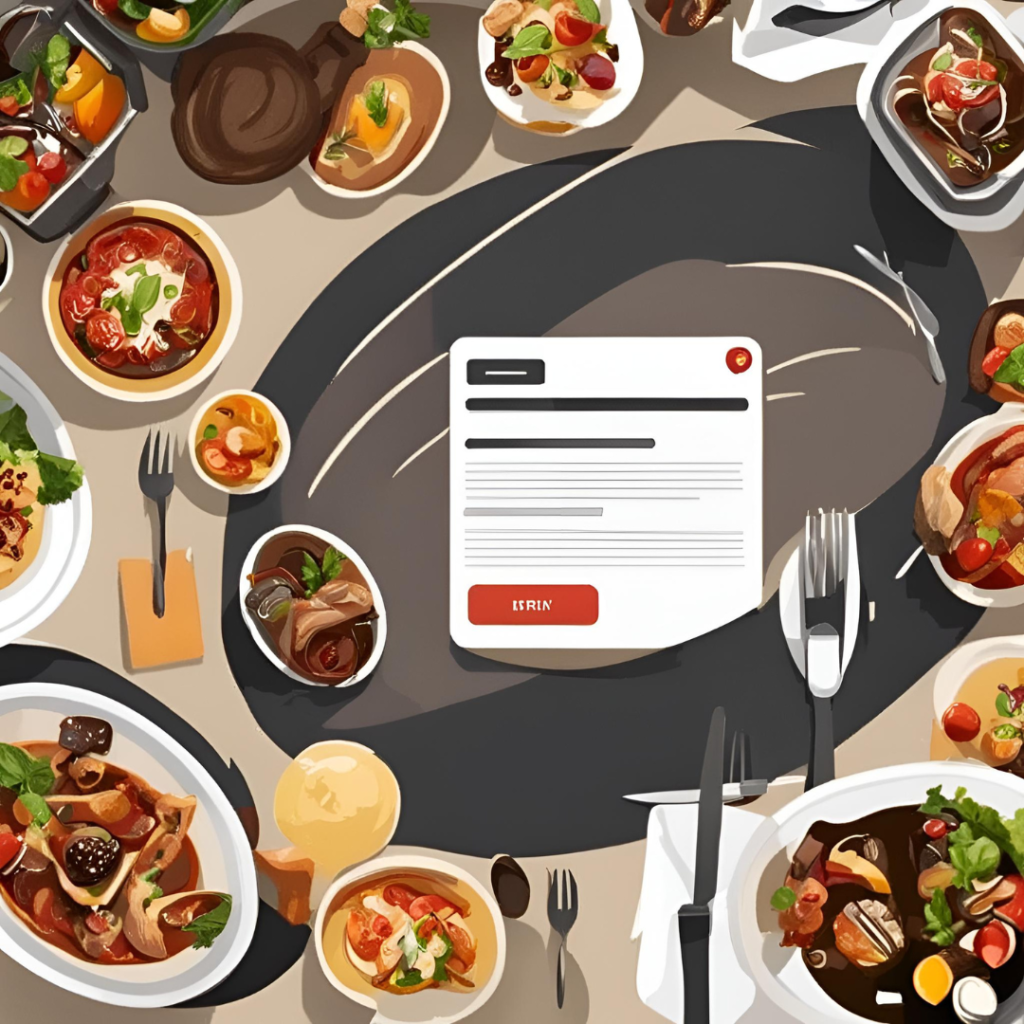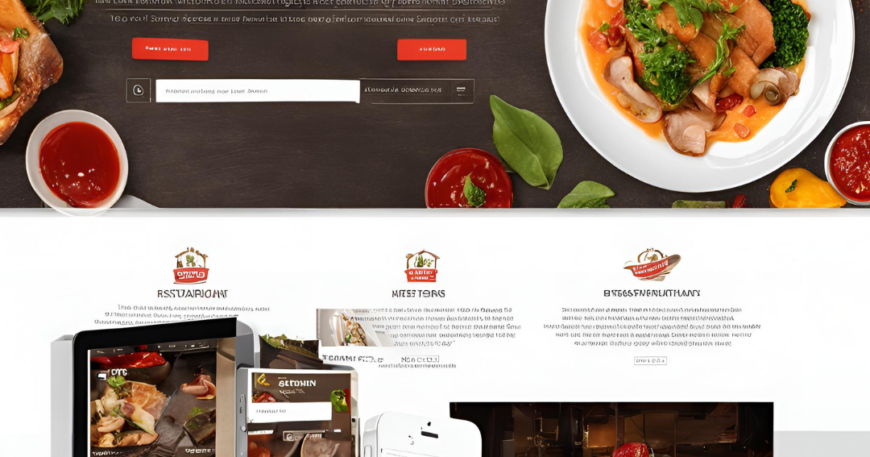In today’s digital age, your restaurant’s website is more than just an online presence—it’s the virtual front door to your culinary world. An effective website attracts new customers, enhances their dining experience, and keeps them coming back. Let’s dive into some top design tips to make sure your restaurant’s website not only looks good but also performs exceptionally.

Understanding Your Audience
Before diving into the design, it’s crucial to understand who your audience is. Are you catering to young foodies, families, or perhaps a corporate crowd? Knowing your target demographic will influence everything from your website’s color scheme to the type of content you include.
Defining your target demographic: Consider the age, income level, and interests of your typical customer. Use this data to tailor your website’s design and functionality to meet their needs.
Catering to user preferences and behaviors: Study your audience’s online habits. Do they prefer browsing on mobile devices or desktops? Are they active on social media? Use this information to optimize your site for the best user experience.
Essential Features for a Restaurant Website
A well-designed restaurant website should include several core features to provide a seamless user experience.
Clear Navigation
User-friendly menu structure: Organize your site so visitors can easily find what they’re looking for. Use a simple, intuitive layout with clear headings and subheadings.
Essential pages: At a minimum, your website should have a Home, Menu, About, and Contact page. Each page should serve a specific purpose and be easily accessible from the main navigation.
High-Quality Visuals
Importance of professional photography: High-quality images of your dishes, interior, and events can entice potential customers. Invest in professional photography to showcase your restaurant in the best light.
Using images to tell your brand story: Photos aren’t just for aesthetics; they should convey the essence of your brand. Whether it’s a cozy café or a chic fine-dining establishment, your visuals should reflect your restaurant’s unique personality.
Responsive Design
Mobile optimization: With the majority of users accessing websites on their phones, a mobile-friendly design is essential. Ensure your site looks great and functions well on all screen sizes.
Testing across devices: Regularly test your website on various devices and browsers to ensure a consistent experience for all users.
Menu Design and Presentation
Your menu is often the first thing visitors look for, so it should be both attractive and informative.
Interactive Menus
Benefits of dynamic menu pages: An interactive menu can enhance the user experience by allowing visitors to filter items based on dietary preferences or search for specific dishes.
Incorporating dietary filters: Make it easy for customers to find vegan, gluten-free, or other specific options by including filter options on your menu page.
Accurate Descriptions and Pricing
Importance of detailed menu descriptions: Include mouth-watering descriptions of each dish along with the ingredients and preparation methods. This not only helps in decision-making but also enhances the overall dining anticipation.
Regular updates for pricing and availability: Keep your menu up-to-date to reflect current prices and available dishes. Nothing frustrates customers more than outdated information.
Online Reservation and Ordering Systems
Integrating online reservations and ordering can significantly improve the user experience and increase your restaurant’s efficiency.
Easy Booking Process
Integration of reservation widgets: Use a reliable reservation system that allows customers to book tables easily from your website. Tools like OpenTable or Resy are popular choices.
User experience considerations: Make the booking process straightforward, with minimal steps and clear instructions to avoid any confusion.
Streamlined Online Ordering
Key features for an effective ordering system: Ensure your online ordering system is user-friendly, allowing customers to customize their orders, view estimated delivery times, and track their orders.
Ensuring secure payment processing: Use secure payment gateways to protect your customers’ data and build trust in your online ordering system.
Integrating Customer Reviews and Testimonials
Showcasing positive reviews and testimonials can build credibility and encourage new customers to visit your restaurant.
Importance of Social Proof
Showcasing positive reviews: Highlight customer testimonials on your homepage and menu pages. Use quotes or ratings from Yelp, Google, or other review platforms.
Responding to feedback: Engage with customers by responding to reviews, whether they are positive or negative. This shows that you value their opinions and are committed to improving their experience.
Location and Contact Information
Make it easy for customers to find and contact you with clear location details and contact options.
Displaying Address and Map
Integration with Google Maps: Embed a Google Map on your website to show your exact location, making it easy for visitors to get directions.
Highlighting parking and accessibility: Provide information about parking options and accessibility to ensure a smooth visit for all customers.
Contact Forms and Links
Effective use of contact forms: Include a simple contact form on your site for inquiries and feedback. Ensure it’s easy to use and clearly labeled.
Incorporating social media links: Connect your website with your social media profiles to boost engagement and keep customers informed about updates and promotions.
Enhancing User Experience with Extras
Adding extra features to your website can improve user engagement and provide added value to your customers.
Event Calendars and Promotions
Highlighting special events: Use an event calendar to showcase upcoming events such as live music, wine tastings, or holiday specials.
Offering promotions and discounts: Attract more customers by featuring current promotions and discounts prominently on your website.
Blog and News Updates
Benefits of a restaurant blog: A blog can provide updates on new menu items, behind-the-scenes stories, and other interesting content that keeps visitors engaged and encourages repeat visits.
Keeping customers informed: Use your blog to share news about the restaurant, such as changes in opening hours, special events, or new hires.
SEO Best Practices for Restaurant Websites
Optimizing your website for search engines is crucial to attract new customers and increase visibility online.
Keyword Optimization
Using location-based keywords: Include keywords related to your restaurant’s location to improve local search rankings. For example, “Italian restaurant in Boston.”
Integrating menu-related terms: Use specific terms related to your menu, such as “gluten-free pizza” or “vegan desserts,” to attract searches for these items.
Meta Tags and Descriptions
Crafting compelling meta descriptions: Write clear and engaging meta descriptions for each page to improve click-through rates from search engines.
Utilizing alt text for images: Use descriptive alt text for images to enhance accessibility and improve your site’s SEO.
Performance and Security Considerations
A fast, secure website enhances user experience and builds trust with your customers.
Speed Optimization
Importance of fast load times: Slow websites can drive users away. Aim for load times under 3 seconds to keep visitors engaged.
Techniques for improving performance: Optimize images, leverage browser caching, and minimize CSS and JavaScript to boost site speed.
Website Security
Implementing SSL certificates: An SSL certificate ensures that data transmitted between your website and users is encrypted, enhancing security and trust.
Protecting customer data: Use secure payment processors and comply with data protection regulations to safeguard customer information.
Analyzing and Improving Website Performance
Regularly analyzing your website’s performance helps identify areas for improvement and ensures ongoing success.
Using Analytics Tools
Tracking user behavior: Use tools like Google Analytics to monitor how visitors interact with your site, which pages they visit, and how long they stay.
Measuring success with key metrics: Track key metrics such as bounce rate, conversion rate, and average session duration to gauge your site’s effectiveness.
Continuous Improvement
Importance of regular updates: Keep your website content fresh and relevant by regularly updating menus, photos, and blog posts.
Gathering and acting on user feedback: Solicit feedback from customers and use it to make continuous improvements to your site’s design and functionality.
Conclusion
Creating a standout restaurant website involves more than just a sleek design; it requires a strategic approach to meet the needs of your audience and enhance their experience. By incorporating these tips, you’ll not only attract more visitors but also convert them into loyal customers.
FAQs
1. Why is mobile optimization crucial for restaurant websites?
Mobile optimization ensures that your website functions well on smartphones and tablets, which is essential as a large number of users browse and make reservations on these devices.
2. How often should I update my restaurant’s online menu?
You should update your online menu regularly, ideally whenever there are changes in pricing, new dishes are added, or items are removed. Regular updates keep your customers informed and avoid disappointment.
3. What are the benefits of integrating customer reviews on my website?
Customer reviews provide social proof, build trust, and can influence new visitors to choose your restaurant. Positive testimonials can enhance your reputation and attract more customers.
4. How can I make my restaurant website stand out from the competition?
Focus on high-quality visuals, a user-friendly interface, and unique content such as a blog or events calendar. Ensure your site is SEO-optimized and regularly updated to keep it fresh and engaging.
5. What security measures are necessary for an online ordering system?
Implement SSL certificates, use secure payment gateways, and comply with data protection regulations to ensure that customer data is handled safely and securely.





